Tivemos momentos em que tudo parecia bem no WordPress, mas o link do post exibia um erro 404 em vez disso. Nenhuma alteração no conteúdo — apenas uma página ausente que deveria estar lá.
Isso geralmente aparece após ajustar configurações, trocar de tema ou adicionar código que afeta silenciosamente os permalinks. Pode te pegar de surpresa, especialmente se o resto do seu site estiver funcionando perfeitamente.
Sempre que encontramos erros 404 inesperados, seguimos um processo simples para colocar os URLs dos posts de volta nos trilhos — sem adivinhações, sem solução de problemas pesada. E é exatamente isso que estamos compartilhando com você neste guia.
Você será capaz de corrigir os erros 404 e garantir que seus posts estejam carregando como deveriam.

Por Que Meus Posts do WordPress Estão Retornando um Erro 404?
Existem várias razões pelas quais seus posts podem estar exibindo um erro 404 "Página Não Encontrada" no WordPress. Estes podem incluir:
- Conflitos de plugin ou tema: Às vezes, plugins ou temas que você instalou em seu site podem interferir na forma como o WordPress lida com permalinks. Isso pode levar a links quebrados e erros 404.
- Problemas de código personalizado: Se você adicionou código personalizado ao seu site, pode haver erros no código que estão afetando os permalinks ou causando outros conflitos, resultando em erros 404 para seus posts.
- Problemas com seu arquivo .htaccess: O arquivo .htaccess desempenha um papel na forma como o WordPress estrutura os URLs. Se este arquivo estiver corrompido ou ausente, isso pode levar a erros 404 em suas postagens ou páginas.
Como Encontrar Todas as Postagens do WordPress com Erros 404
Antes de passarmos para as soluções, seria bom descobrir se este erro está acontecendo apenas em uma ou duas postagens ou em várias. Dessa forma, você pode determinar a extensão do problema e escolher a solução mais apropriada.
Uma maneira fácil de descobrir isso é usar o Google Search Console. Se você ainda não enviou seu site para o Google Search Console, leia nosso guia sobre como adicionar seu site WordPress ao Google Search Console.
Assim que o bot do Google rastrear e indexar seu site, o Google Search Console fornecerá informações detalhadas sobre o desempenho do seu site, incluindo quaisquer erros 404 que ele encontrar.
Para descobrir quais postagens estão retornando erros 404, você pode fazer login no painel do Search Console. Em seguida, navegue até o relatório 'Páginas' e você verá uma lista detalhada de todos os erros.
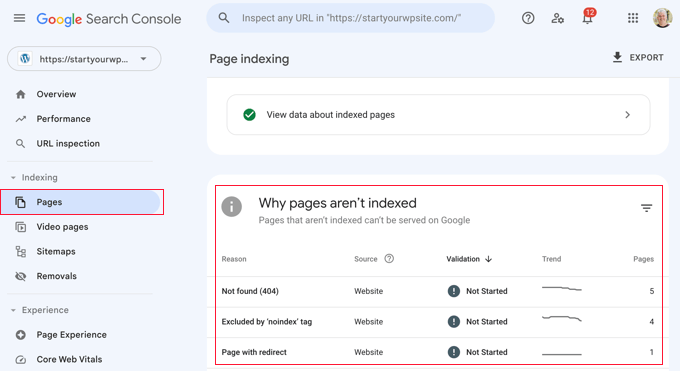
Para mais informações, você pode ler nossa lista de dicas para usar o Google Search Console para aumentar o tráfego do site, que inclui algumas dicas sobre como corrigir erros 404 com a ferramenta.
Dito isso, vamos ver como corrigir postagens do WordPress que retornam erros 404. Você pode usar os links abaixo para pular diretamente para diferentes soluções:
- Método 1: Verifique Conflitos de Plugins ou Temas e Problemas de Código Personalizado
- Método 2: Corrija Suas Configurações de Permalink
- Método 3: Atualize o Arquivo .htaccess do WordPress
- Método 4: Entre em Contato com Seu Provedor de Hospedagem
- Method 5: Enable mod-rewrite (Local WordPress Installation)
- Perguntas Frequentes Sobre Erros 404 do WordPress
- 🎁 Bônus: Guia Adicional sobre Como Lidar com Erros 404
Método 1: Verifique Conflitos de Plugins ou Temas e Problemas de Código Personalizado
Às vezes, plugins, temas ou códigos personalizados que você adicionou ao seu site WordPress podem interferir nos permalinks ou causar conflitos, levando a erros 404. Nós mesmos já experimentamos isso quando estamos testando ferramentas em nosso site de demonstração.
Uma maneira de resolver esse problema é desativar plugins temporariamente. Plugins às vezes podem atrapalhar a forma como o WordPress lida com links.
Depois de desativar os plugins, você pode reativá-los um por um, verificando se o erro 404 reaparece após ativar cada plugin. Se o erro aparecer após a ativação de um plugin específico, esse pode ser o culpado.
Você pode então fazer uma rápida pesquisa no Google por soluções relacionadas a esse plugin ou entrar em contato com o desenvolvedor do plugin para obter suporte.
Da mesma forma, seu tema do WordPress pode estar causando o conflito.
Para verificar, você pode mudar temporariamente para um tema padrão do WordPress como o Twenty Twenty-Three ou Twenty Twenty-Four. Tudo o que você precisa fazer é ir em Aparência » Temas e clicar em ‘Ativar’ em um tema padrão.

Se o erro 404 desaparecer com o tema padrão, isso indica um conflito potencial com seu tema atual. Você pode então tentar solucionar o problema do tema ou considerar o uso de um tema diferente.
Você pode conferir nossa seleção especializada dos temas do WordPress mais populares para recomendações.
Se você inseriu recentemente snippets de código em seu site, pode haver erros no código causando os erros 404. Dê uma olhada atenta no código que você adicionou e veja se consegue identificar algum erro.
A maneira mais segura de adicionar snippets de código ao WordPress é com o plugin WPCode. Este plugin permite que você insira código personalizado sem trabalhar diretamente com os arquivos do tema, reduzindo o risco de quebrar seu site.
Além disso, sempre que o WPCode detectar um erro no seu código, ele desativará automaticamente o snippet e pedirá para você verificá-lo. Você também pode usar o modo de teste para verificar se o seu código funciona antes de publicá-lo em seu site ativo.

Se nenhuma dessas soluções funcionar, passe para o próximo método, onde solucionaremos os problemas de suas configurações de permalink.
Método 2: Corrija Suas Configurações de Permalink
Posts do WordPress podem retornar erros 404 devido a problemas com as regras de reescrita em seu arquivo .htaccess. Na maioria dos casos, você pode corrigir o problema atualizando suas configurações de permalink.
Simplesmente vá para Configurações » Permalinks no seu painel do WordPress e clique no botão ‘Salvar alterações’.

Não há necessidade de fazer alterações nas próprias configurações de permalink. Isso atualizará suas configurações de permalink e limpará as regras de reescrita.
Na maioria dos casos, essa solução corrige o erro 404 de posts do WordPress. No entanto, se não funcionar para você, provavelmente precisará atualizar seu arquivo .htaccess manualmente.
Método 3: Atualize o Arquivo .htaccess do WordPress
Antes de começar, certifique-se de fazer backup do seu arquivo .htaccess do WordPress primeiro. Se algo der errado, você poderá restaurar facilmente o arquivo original.
Agora, você precisará conectar-se ao seu servidor usando um cliente FTP como FileZilla ou o Gerenciador de Arquivos no painel de controle da sua hospedagem.
Em seguida, encontre o arquivo .htaccess na pasta raiz do seu site — este é o mesmo diretório que contém pastas como /wp-content/ e /wp-includes/.
Clique com o botão direito no arquivo e selecione ‘Permissões de arquivo’ ou ‘Alterar permissões’ no seu cliente FTP.
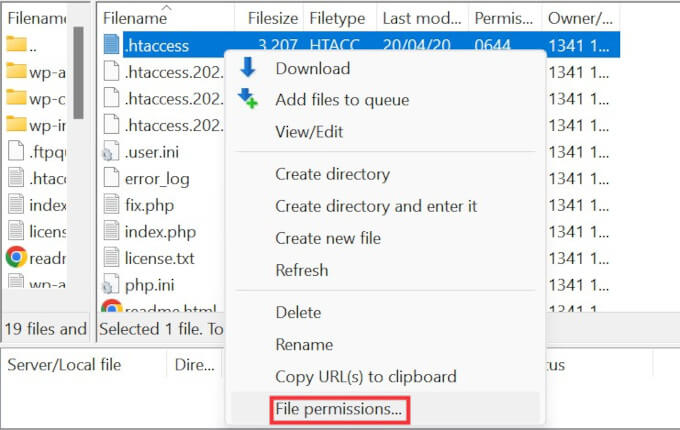
Se o WordPress não conseguiu escrever no arquivo antes, tente alterar temporariamente suas permissões para 666 para torná-lo gravável.
Depois disso, volte para a área de administração do WordPress e salve novamente suas configurações de link permanente. Isso permite que o WordPress regenere um arquivo .htaccess adequado.
Assim que isso for feito, certifique-se de alterar as permissões do arquivo de volta para uma configuração mais segura: 644. Esta configuração permite que o WordPress leia o arquivo, enquanto ainda o protege de alterações não autorizadas.

Alternativamente, você pode editar o arquivo manualmente.
Simplesmente clique com o botão direito no arquivo .htaccess e selecione a opção Visualizar/Editar.
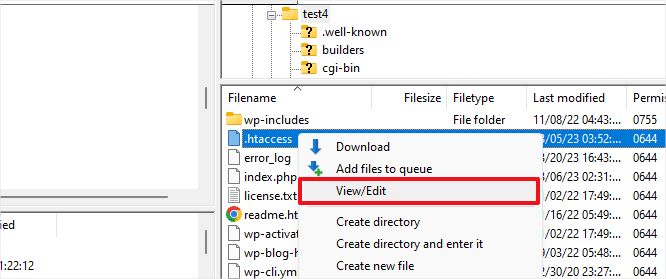
O arquivo será aberto em um editor de texto simples como o Bloco de Notas ou o TextEdit.
Agora você precisa adicionar as seguintes regras de reescrita padrão do WordPress:
# BEGIN WordPress
<IfModule mod_rewrite.c>
RewriteEngine On
RewriteBase /
RewriteRule ^index\.php$ - [L]
RewriteCond %{REQUEST_FILENAME} !-f
RewriteCond %{REQUEST_FILENAME} !-d
RewriteRule . /index.php [L]
</IfModule>
# END WordPress
Método 4: Entre em Contato com Seu Provedor de Hospedagem
Se nenhuma das soluções acima corrigiu o erro 404 nos posts do WordPress, recomendamos que você entre em contato com seu provedor de hospedagem WordPress. Pode haver um erro do lado deles, ou eles podem ajudá-lo a solucionar o problema.
Por favor, veja também nosso guia sobre como pedir suporte WordPress corretamente e obtê-lo.
Método 5: Habilitar mod-rewrite (Instalação Local do WordPress)
Se você estiver usando um servidor local para fins de teste, você precisará habilitar o mod_rewrite na configuração do Apache do seu site MAMP, WAMP ou XAMPP.
Isso permitirá que o WordPress gere URLs limpas e evite o erro 404 para posts e páginas em seu servidor local.
A forma de fazer isso varia de acordo com a plataforma que você usa. Pessoas que usam XAMPP podem abrir o painel de controle e clicar no botão ‘Config’ em Ações. Em seguida, selecione ‘Apache (httpd.conf)’.
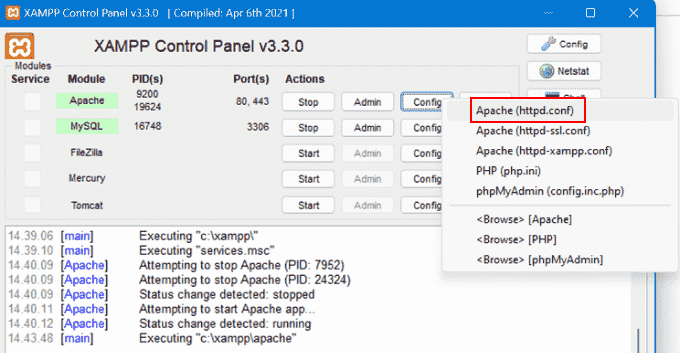
Em seguida, você precisará encontrar a linha #LoadModule rewrite_module modules/mod_rewrite.so e remover o ‘#’ para descomentá-la.
Isso carregará o mod_rewrite.
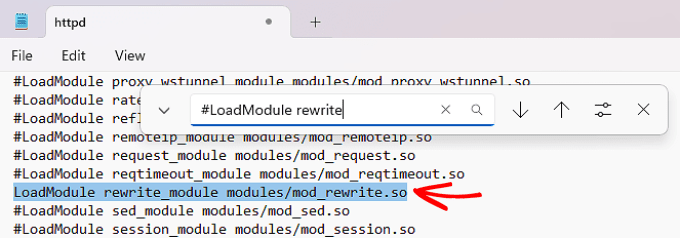
Em seguida, procure as linhas que dizem AllowOverride None e altere-as para AllowOverride All. Isso informa ao Apache para permitir o uso de arquivos .htaccess.
Você normalmente encontrará isso dentro de blocos <Directory> — especialmente aquele que aponta para a pasta do seu site, como htdocs se você estiver usando XAMPP. Se você não tiver certeza, tudo bem aplicar a alteração onde quer que a veja dentro do arquivo, desde que não seja um diretório do sistema. Para testes locais, isso geralmente funciona muito bem.

Depois de feito, você pode salvar o arquivo httpd.conf e fechá-lo. Depois disso, no painel de controle do XAMPP, clique em ‘Stop’ no módulo Apache e ‘Start’ novamente para reiniciá-lo.
Em seguida, volte ao seu painel de administração para ver se seus permalinks estão funcionando.
Tutorial em Vídeo
Se você precisar de instruções visuais, basta assistir ao vídeo abaixo.
Perguntas Frequentes Sobre Erros 404 do WordPress
Encontrar erros 404 no seu site WordPress pode ser confuso. Abaixo, respondemos a perguntas comuns que podem ajudá-lo a solucionar e corrigir o problema de forma mais eficaz.
1. Por que estou recebendo um erro 404 nas minhas postagens do WordPress?
Isso geralmente significa que o WordPress não consegue encontrar a postagem no URL solicitado. Pode acontecer devido a permalinks quebrados, um arquivo .htaccess corrompido, postagens excluídas ou um conflito de plugin/tema que altera como os URLs são tratados.
2. Como corrijo um erro 404 no WordPress?
Tente salvar novamente suas configurações de permalink indo em Configurações » Permalinks e clicando em ‘Salvar alterações’. Se isso não funcionar, verifique seu arquivo .htaccess, desative plugins ou mude para um tema padrão para descartar conflitos.
3. Como posso encontrar todos os erros 404 no meu site WordPress?
Você pode usar o Google Search Console para ver uma lista de erros 404 que o Googlebot encontra. Plugins como Broken Link Checker também podem ajudar a identificar links quebrados e páginas ausentes dentro do seu site.
4. O que o arquivo .htaccess faz no WordPress?
O arquivo .htaccess controla como os URLs são processados. O WordPress o usa para gerenciar a estrutura de permalinks e rotear URLs para o conteúdo correto. Se ele estiver ausente ou corrompido, os URLs podem parar de funcionar corretamente.
5. Como edito o arquivo .htaccess com segurança?
Você pode editá-lo usando um cliente FTP ou o gerenciador de arquivos da sua hospedagem. Sempre faça um backup primeiro. Após a edição, certifique-se de que as permissões estejam definidas como 644 para que ele permaneça legível e seguro.
6. Por que minhas páginas de categoria ou tag do WordPress mostram erros 404?
Isso pode acontecer se o seu tema não suportar modelos de arquivo (archive templates) ou se as configurações de permalink estiverem mal configuradas. Salvar os permalinks novamente e verificar o suporte de arquivo do seu tema pode ajudar a corrigir isso.
7. Como corrijo erros 404 para tipos de postagem personalizados?
Visite Configurações » Permalinks e clique em ‘Salvar alterações’ para atualizar as regras de reescrita. Além disso, verifique se o seu tipo de postagem personalizado está registrado com as configurações de reescrita corretas e tem suporte de arquivo, se necessário.
8. Posso redirecionar páginas 404 para a minha página inicial ou outra página?
Sim, plugins como Redirection permitem que você crie redirecionamentos 301 de URLs antigas ou quebradas para novas. Você também pode criar uma página 404 personalizada para guiar os usuários de volta a conteúdo útil.
🎁 Bônus: Guia Adicional sobre Como Lidar com Erros 404
Você também pode achar os seguintes recursos úteis para gerenciar erros 404 e outros erros comuns do WordPress.
- Como Melhorar seu Template de Página 404 no WordPress (2 Maneiras)
- Melhores Exemplos de Design de Página de Erro 404 do WordPress
- Melhores Plugins Gratuitos de Redirecionamento 404 para WordPress
- Como Receber Alertas por E-mail para Erros 404 no WordPress
Esperamos que este artigo tenha ajudado você a resolver os posts que retornam erros 404 no WordPress. Você também pode querer ver nosso guia sobre os erros mais comuns do WordPress e como corrigi-los, juntamente com nossas escolhas de especialistas para os melhores plugins do WordPress para expandir seu site.
Se você gostou deste artigo, por favor, inscreva-se em nosso Canal do YouTube para tutoriais em vídeo do WordPress. Você também pode nos encontrar no Twitter e no Facebook.





Thomas Elkin II
Infelizmente, isso não me ajudou. Nenhuma das soluções funcionou. Alguém tem outra sugestão(ões)?
Sharma Rahul
Valeu, obrigado cara!! salvou minha noite (y)
Javier Rodriguez
Uauuu. uma semana tentando descobrir o que estava errado e era o problema do WAMP. corrigi com um clique. muito obrigado
Ben
Obrigado. Aconselhamento claro que me poupou muitas horas de pânico.
Milan
Procurando solução em muitos sites... Mas sem sorte E depois de tudo tentei o seguinte
Configurações » Links Permanentes, e simplesmente clique no botão Salvar Alterações.
Isso funcionou!!
Million Thanks To Team WpBeginner….. !!
minacio
Ótima ajuda, muito obrigado!
So easy!
Jeff
Receio que isso não funcionou para mim. Continuo recebendo o erro 404 e ele afeta todos os links da minha página inicial. No entanto, se eu definir as configurações de Links Permanentes para "Padrão", tudo funciona. Eu não quero as configurações padrão, porém – quero que os links permanentes usem "Dia e nome". Eu também verifiquei o arquivo .htaccess e ele está ok. Eu fiz o mesmo para permissões e elas também estão boas. Ajuda!
WPBeginner Support
Jeff, você tentou excluir seu arquivo .htaccess? Após excluí-lo, você precisa ir em Configurações » Links Permanentes e salvar suas configurações de links permanentes desejadas.
Admin
Rick Harris
Então, essa dica funciona parcialmente para mim. Eu só tenho o problema 404 em 1 post, mas é o meu primeiro, então é o 'sobre o que é este blog e o que você encontrará aqui', então é muito importante para o site do blog.
Veja se você consegue descobrir isso.
Se eu definir os permalinks para algo como ano/mês/nome do post, funciona bem.
Mesmo se eu excluir o arquivo htaccess e depois fizer a alteração, definindo-o para 'nome do post', resulta nesse post recebendo o 404. Ele ainda será exibido nas páginas inicial e de categoria, no entanto.
Alejandro
Thanks!!! …fixing the Permalinks did it for me! (;
…fixing the Permalinks did it for me! (;
Gaston
Ha ha, tão fácil! obrigado!
Indonésio
muito útil.. muito obrigado… Você é demais, cara.. !!
Annie
Eu passei por essas duas opções e ainda estou recebendo um erro 404. Tenho meus permalinks definidos como 'nome do post', mas por algum motivo apenas UM dos meus posts está preso em uma estrutura de permalink diferente (o post termina com /3088 em vez disso) e não muda quando eu atualizo os permalinks. Eu também entrei no meu arquivo .htaccess, e ele já tinha o código que você tinha acima nele, mas não havia nada sobre permissões no arquivo. Há algo que eu possa fazer para fazer este post aparecer? Eu posso vê-lo no feed da minha página inicial, mas recebo o erro quando clico nele para ir para a página do post.
Ashleigh
Estou tendo o mesmo problema… AJUDA
Scotty
simmm. obrigado por este post – realmente salvou minha pele!
Roel
Você é um chefe.
Emily Gates
Obrigado administrador, eu estava muito preocupado com isso, na verdade instalei um plugin de categoria (porque estou rodando meu blog que é facebookstatuss.com) e após a desativação descobri que meu post único não estava mostrando corretamente, um erro 404 era exibido, mas agora eu consertei. Obrigado por dar a solução.
Marx
Cara, você é o cara.
Amon Lucas
Obrigado ! Obrigado .
Somesh
Mudei meu tema por um tempinho. E ele tem seções diferentes por padrão no painel.
Gadgets
Video Games
Como Fazer
Então, depois de reaplicar o tema novamente, os posts na seção de posts estão funcionando bem. Mas, os posts para essas seções dizem página não encontrada.
Como trazer esses posts de volta? Os posts estão disponíveis no painel, mas suas miniaturas também estão disponíveis no site, mas quando clico nelas, diz página não encontrada.
sven
muito obrigado. você fez o meu dia.
Naser
Muito obrigado. Você alegrou meu dia. Obrigado……
Edgar
Thanks for the info! Was in dispair, but now fine again. Had to do an extra step though. My host provider (hostnet) installed wordpress for me, so I had to get into their config panel to sync the .htacces file. Don’t know if this is more common for people using pre installed wordpress. Just letting you know
Markus Dan
Isso é genial!
Obrigado... você salvou meu dia!
Dani
Ei cara, muito obrigado. Você me poupou muitas horas de trabalho!
Carl
Olá,
meu problema era que o arquivo .htaccess não era gravável.
Tudo o que eu tive que fazer foi definir o chmod para 777, depois pressionar o botão “salvar alterações” no Menu de Opções de Links Permanentes. O WP então limpou corretamente as antigas configurações do .htaccess e as reescreveu.
Funciona, Obrigado!
Ben
Olá, eu tive o mesmo problema em 2 dos meus sites com a edição de posts ou páginas, tudo o mais parecia funcionar bem. (aconteceu ao mesmo tempo)
Eu corrigi mudando as permissões no cpanel/gerenciador de arquivos para 644 para arquivos e 755 para diretórios e tudo foi restaurado ao normal novamente. então verifique com sua hospedagem as configurações recomendadas para permissões de arquivo.
De alguma forma, as permissões de todos os arquivos e diretórios foram definidas para 655 para (todos os arquivos e diretórios do wp).
Alterar as permissões apenas no arquivo .htaccess não resolveu para mim e editá-lo também não resolveu, nem alterar os permalinks. {de alguma forma acho que meu problema veio do lado do meu servidor.}
Espero que seja útil para alguém.
Pankaj Chauhan
Eu estava recebendo o mesmo erro 404 no meu blog. Não estava acontecendo com todos os posts, mas com um post específico. Depois de algumas horas, percebi que o nome da categoria estava causando o problema. então eu deletei a categoria e a recriei com um slug diferente. Funcionou.
mas ainda não tenho certeza por que aconteceu…
Felizmente, naquela categoria, eu não tinha posts, caso contrário… teria sido um problema, pois eu teria que reatribuir a nova categoria a todos os posts.
JP van der Meer
Muito obrigado, me ajudou!
I did delete the .htaccess
Obrigado!
Manisha Sarangi
Olá,
Eu tenho outra solução e funcionou como mágica.
Basta seguir alguns passos aqui.
Para UBUNTU :
1.Você precisa habilitar o mod_rewrite no servidor apache
sudo a2enmod rewrite
2.Você precisa reiniciar o servidor web para aplicar as alterações
sudo service apache2 restart
3. Se você planeja usar o mod_rewrite em arquivos .htaccess, você também precisa habilitar o uso de arquivos .htaccess alterando AllowOverride None para AllowOverride FileInfo. Para o site padrão, edite /etc/apache2/sites-available/default
Opções Índices FollowSymLinks MultiViews
# alterado de None para FileInfo
AllowOverride FileInfo
Order allow,deny
allow from all
4.Após tal alteração, você precisa reiniciar o Apache novamente
sudo service apache2 restart
5. Em seguida, vá para o painel do WordPress > configurações > links permanentes > selecione nome do post e salve as alterações
Vai funcionar agora.
Obrigado
David Vitorino
Obrigado por este post!!
Eu estava tentando instalar o WordPress no koding.com VPS e seu post realmente me ajudou.
o mod_rewrite estava desativado no apache.
Kudos
seb okelly
Este post corrigiu meu problema, que eu tinha piorado mexendo no Codex. Obrigado.
Syl
Olá!
Obrigado pelo seu post. Tenho um problema semelhante no meu blog WordPress e não sei o que fazer agora. Para encurtar a história, meu arquivo .htaccess está sendo sobrescrito repetidamente...
Estas linhas:
# BEGIN WordPress
RewriteEngine On
RewriteBase /
RewriteRule ^index\.php$ – [L]
RewriteCond %{REQUEST_FILENAME} !-f
RewriteCond %{REQUEST_FILENAME} !-d
RewriteRule . /index.php [L]
# FIM WordPress
são duplicadas cem ou mil vezes com caracteres NUL, e meu .htaccess agora tem 1,5 Mo! Posso corrigir o problema carregando um .htaccess limpo, mas o problema ocorre algumas horas/dias depois, repetidamente, e as páginas dos meus sites mostram um erro 404...
Eu também tentei definir os atributos do arquivo htaccess para 404 em vez de 604 para impedir que ele fosse reescrito, mas meu host não permite isso e ele voltou para 604...
WordPress: 3.6.1 Plugins: Akismet, Anti-spam, DB Cache Reloaded Fix, Do Follow, Google Analytics para WordPress, Post Ratings, Recipe Card, Tweet, Like, Google +1 e Share, UberMenu, WordPress Database Backup, WordPress SEO, WP Sitemap Page, WP Super Cache
Alguma ideia?
Best regards
WPBeginner Support
Desative todos os seus plugins. Se você tiver algum código personalizado colado no arquivo functions.php do seu tema, crie um backup do seu arquivo existente e, em seguida, instale uma cópia nova do seu tema. Exclua o seu arquivo .htaccess. Vá para Configurações » Links Permanentes e salve seus links permanentes. Agora conecte-se ao seu site usando FTP, o WordPress terá criado um novo arquivo .htaccess para você. Navegue por algumas páginas no front-end do seu site e veja se as alterações no seu arquivo .htaccess reaparecem.
Admin
MissyLee
Many many thanks for continuing with helping people – My child theme functions.php was the problem. Seriously, this is a great site!
Megha Verma
Olá, estou enfrentando o problema de erro 404 página não encontrada. Mas isso não se aplica a todas as postagens. Este problema ocorre em 5 de 10. Além disso, estou usando o mesmo método para criar todas as postagens e a estrutura do link permanente é /sample-post/. Por favor, ajude-me a resolver isso e forneça a melhor solução.
Ana Villegas
Incrível! Isso me ajudou muito, obrigadúúúú! <3
Biswajit Rout
Olá,
Obrigado pela informação. Tenho o mesmo problema.
Mas agora eu corrigi adicionando o código abaixo no meu .htaccess.
# BEGIN WordPress
RewriteEngine On
RewriteBase /
RewriteRule ^index\.php$ – [L]
RewriteCond %{REQUEST_FILENAME} !-f
RewriteCond %{REQUEST_FILENAME} !-d
RewriteRule . /index.php [L]
# FIM WordPress
Obrigado novamente por este post.
Jyo
Hi, thanks for the info, but it doesnt work for me Please admin can you help me out. My permalinks arent working. I have tried your method. The only way its working is by setting permalinks to default else the whole site comes down, not even the wp admin section is accessible.
Please admin can you help me out. My permalinks arent working. I have tried your method. The only way its working is by setting permalinks to default else the whole site comes down, not even the wp admin section is accessible.
WPBeginner Support
Aqui está algo que você pode tentar. Conecte-se ao seu site WordPress usando um cliente FTP como o Filezilla. Uma vez conectado ao seu site, na barra de menu do Filezilla clique em Servidor » Forçar exibição de arquivos ocultos. Encontre o arquivo .htaccess no diretório raiz do seu site, baixe-o para o seu computador e, em seguida, exclua o arquivo do seu servidor. Agora vá para a área de administração do WordPress no seu navegador e clique em Configurações » Links Permanentes. Escolha uma estrutura de link permanente para o seu site e clique no botão salvar alterações. Esperançosamente, isso resolverá seu problema.
Admin
Elizabeth
Este erro 404 estava me deixando louco!. Obrigado por esta informação instrutiva!
Decio Denis Bernardo
Obrigado.. legal e fácil!
karen
Pensei que já tinha estragado meu blog e não conseguia mais fazê-lo funcionar. Obrigado por este post legal!
Darren
Você é INCRÍVEL! Eu não tinha ideia do que estava errado. 5 minutos lendo seu post e alguns cliques depois meu blog está funcionando novamente! Obrigado MUITO!
Gav Reichel
Se nada do acima estiver fazendo diferença para você, pode valer a pena perguntar ao administrador do seu site se eles adicionaram o seguinte à configuração (se estiver usando apache):
Options Indexes Includes FollowSymLinks
AllowOverride All
(Isso geralmente é definido na seção de host virtual)
Se não, seu arquivo .htaccess não será lido!
(Falo por experiência depois de passar 30 minutos tentando descobrir isso!)
pete
Oi, meu htaccess foi hackeado e tive que excluí-lo. Agora tenho este problema. Esta solução só me ajudou pela metade. Da mensagem de erro 404 do navegador (antes) para minha página de erro 404 personalizada do WordPress (depois de redefinir os links permanentes). Alguma ideia?
Equipe Editorial
Você consegue ver que o .htaccess está sendo criado? Se não, talvez você queira adicionar um arquivo .htaccess em branco.
Admin
Pete
Demorou um pouco para eu voltar...
O htaccess parece bom. Ele é atualizado... Ainda não está funcionando. Apenas os permalinks feios personalizados. Outro site WordPress no mesmo servidor foi hackeado ao mesmo tempo. Mas nesse, este conserto resolve o problema.
protik
Obrigado, muito obrigado… tive um leve ataque de pânico quando o erro 404 aconteceu… este post foi uma salvação!!
Rod Salm
A correção de links permanentes funcionou para mim, muito obrigado!
Rod Salm
Peter
Obrigado, obrigado, obrigado.
Funcionou.
Você está certo, há tantas variáveis que às vezes saber o que perguntar é significativamente mais difícil do que resolver o problema.
Agora consigo acessar meu blog novamente.
tenha um ótimo dia.
Peter Sitting Scribe
Allii Allee
eu fiz todos os passos, mas ainda está me dando este erro
Erro 404
A página que você solicitou não pode ser exibida. Parece que você perdeu seu destino pretendido, seja por um link ruim ou desatualizado, ou um erro de digitação na página que você esperava alcançar.
Akhil Gupta
antes de mais nada, quero agradecer por este ótimo tutorial.. não consigo mudar o link permanente há 2 horas.. eu estava mudando o arquivo .htaccess, mas não estava funcionando, mas depois de ver seu post sobre erro 404, consegui descobrir e agora meu problema está resolvido. Obrigado mais uma vez
SBC
Obrigado, isso realmente me ajudou a resolver os problemas com meu site…
Bruce Ketchum
Obrigado, WPBeginner! Sua dica de clicar no botão Salvar Alterações nas configurações de Permalinks do WordPress corrigiu meu erro 404, que estava ocorrendo em posts e páginas.
Imran Hossain
Este é um tutorial muito importante para mim. Hoje aprendi sobre o erro 404 Not Found.
Adrian D'Amico
Eu também estou tendo esse problema em um dos meus sites – onde ele continua acontecendo a cada poucos dias, mesmo depois de eu clicar em Salvar Alterações e atualizar os Permalinks. Estou imaginando que seja um plugin, mas ainda não desativei e reativei um por um, pois teria que esperar dias para descobrir qual deles está causando isso. Você acha que a solução de edição do htaccess que você descreve é uma solução permanente, ou o problema ressurgirá novamente? Obrigado por qualquer ajuda que você possa fornecer.
Equipe Editorial
Todo site WordPress que usa permalinks personalizados tem esse código.
Admin
Adrian
Olá – Segui este tutorial, mas meu site ainda está assolado por este problema. Algo está desencadeando isso? Algo como um plugin? Verifiquei novamente e meu arquivo htaccess sempre se parece com o que você sugere no artigo, parece que algo mais está acontecendo, pelo menos no meu caso. Obrigado por qualquer ajuda que você possa fornecer.
Adrian
Acho que o que estou perguntando é se você sabe uma maneira de rastrear o que está causando isso (ou seja, qual plugin, etc.)
Rich
Você tem isso em httpd.conf para arquivos de servidor web – por volta da linha 220 em um arquivo httpd.conf padrão. Seu host pode estar sobrescrevendo as alterações que você fez?
AllowOverride FileInfo
As configurações do meu servidor web não tinham isso, então, apesar de mudar isso nas configurações iniciais do Directory, simplesmente não estava funcionando. Assim que fiz isso, funcionou.
Jay Castillo
A questão é: o que está causando o problema com o arquivo htaccess?
Encontrei este problema antes e descobri que era devido ao uso do plugin diggdigg para WordPress.
A correção rápida foi salvar a estrutura de permalink exatamente como você mencionou acima, mas o problema aconteceu comigo duas vezes (erros 404 nos meus posts, a página inicial estava ok) em uma semana e depois que removi o plugin diggdigg, ele nunca mais ocorreu.
Eu ainda não sei por que aconteceu.